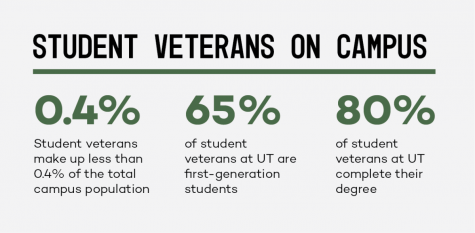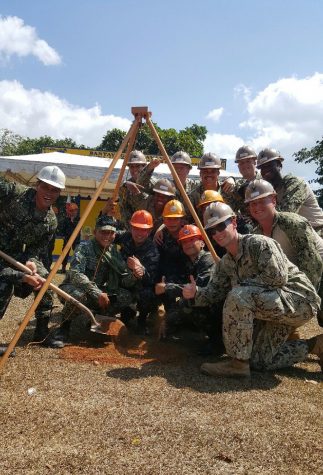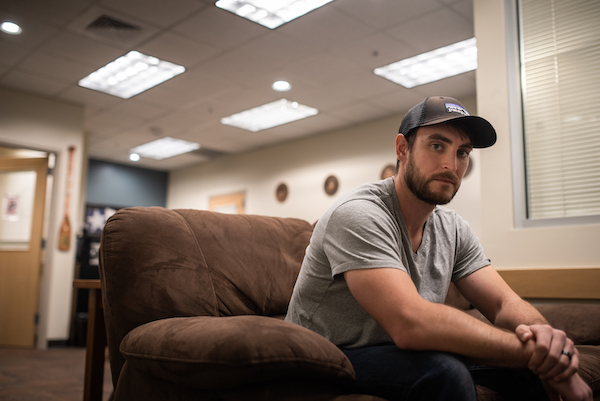Students, not soldiers: A look into UT-Austin’s student veteran community
March 6, 2020
At 29, first-year student Axton Vorpahl sits at the front of classes filled with students potentially a decade younger than him.
While most freshmen have likely only ever known their high schools and college, Vorpahl saw much of the world during his five-year career as a builder in the Navy. Now studying civil engineering at UT, Vorpahl likens his unconventional college experience to “Billy Madison,” a 1995 movie starring Adam Sandler.
“He’s a grown adult, but he has to go back and redo … (years at) his elementary schools,” Vorpahl said. “That’s kind of what it feels like. You’re just this grown adult with 18, 19, 20-year-olds. It’s different.”
Despite making up less than 0.4% of the total campus population — roughly 425 students — UT’s student veteran community is “a huge fraternity of brothers and sisters” who support and lift each other up, said Jeremiah Gunderson, director of Student Veteran Services.

“We’ve all seen and experienced so much, whether it has a bad effect on us or a good effect,” Vorpahl said. “We look at life a lot differently than the majority of the people that go to this school because … they haven’t seen what’s actually going on out there where most of us have, and so it’s nice to be able to be surrounded by similar-minded people in that aspect.”
Student veterans at UT, 65% of whom are first generation, face the challenges of integrating back into civilian life while learning to navigate college and manage their time. They are often older, have families of their own and must take care of financial responsibilities without the support of parents.
Student Veteran Services offers several resources to student veterans like Vorpahl, such as a mentor program and veteran-focused orientation. UT was recently named the best college for veterans in Texas, a state with many military residents, and ranked No.6 nationwide. 80% of student veterans at UT complete their degree, and 77% go on to earn more than $28,000 a year after attendance, according to career website Zippia.
“The main goal of ours is to help (student veterans) understand that you have to transition into a world that’s different,” Gunderson said. “You can’t continue to operate like you did in the military and be successful as a civilian, so it’s really focused on transition.”

Vorpahl said the relationships he has with student veterans at UT are comparable to the ones he had in the Navy — they joke and talk about similar topics. At the Student Veteran Center, where Vorpahl often spends time studying, students and office staff have a fellowship built on shared experiences.
“We call it gallows humor, but … joking about things that other people don’t is a way that a lot of veterans cope with high-stress environments, so it kind of carries over here,” Gunderson said.
Vorpahl said his wife encouraged him to go back to school, but he misses the structure of the Navy. When he was building, Vorpahl would wake up, drive to the project site, come back around 6 p.m., eat, exercise and go to sleep. During deployments, he worked anywhere from 12 to 17 hours a day. Sometimes, he worked 24-hour shifts with few breaks in between, he said.
“It’s constantly going, but you don’t have to really time manage everything because that is all your time,” Vorpahl said of the Navy. “Some people might (have), in their military career, tried (to) take classes. I didn’t have time for that. So time management in the Navy was pretty easy because the Navy was your time.”

After 26 years in the military, where each day was carefully planned, student veteran adviser David Lessenberry said he struggled to budget his time at UT, so he turned to the Sanger Learning Center and younger peers for help. Now, he helps Student Veteran Services’ mentor program and a work-study program.
“I also learned to leverage the traditional students … because … they know this material a lot fresher than I did,” Lessenberry said. “But then I offered them a lot because they … always asked me life questions. So it’s mutually beneficial for a lot of people, and I think that’s a unique thing that veterans bring to campus that a lot of people don’t realize.”
Gunderson said Lessenberry himself helped inspire the mentor program because, as a UT student, Lessenberry would stay late in the Student Veteran Center to explain the registration process to incoming students.
Vorpahl is not participating in the mentor program, but he said he and practically all other UT student veterans go to Lessenberry with their questions. It’s this kind of interconnectedness and unwavering support that motivates Gunderson to do his job well, Gunderson said.
“We had a veteran … (whose) wife came up to me at an event just like, ‘Thank you so much for helping him graduate because he struggled hard here,’ … and I can say without a doubt without our office, he wouldn’t have made it,” Gunderson said. “I think when you help one veteran, you help all of them.”
Gunderson said student veterans should be thought of as students, not soldiers, and emphasized that the Student Veteran Center is not the military or Veterans Affairs — it’s so much more.
“We’ve lost a lot of people,” Gunderson said. “Obviously, that’s what happens in our world, but we think of it as an opportunity, and that’s why we encourage veterans. You’re here, (and) you have this opportunity a lot of other people didn’t get.”



